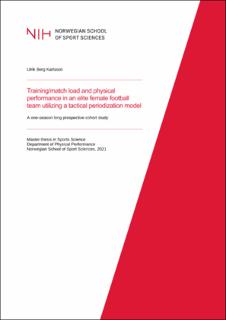| dc.description.abstract | Purpose: Traditional models of training periodization fault in their application to football. The tactical periodization model has been developed to solve programming challenges specific to football. The purpose of this study was to investigate if an elite female football team utilizing a tactical periodization model is successful in differentiating training loads between specific training days within the microcycle, and if microcycle training loads are maintained across the season. Accompanying and associated changes in physical qualities were also investigated.
Methods: Data were collected over the course of a full season from a team playing in the premier women’s division in Norway. A 10 Hz GPS system with a built in 200 Hz IMU (Polar Team Pro) was used to quantify external load. Total distance, high-speed running distance, sprint distance, and the combined number of accelerations and decelerations (ACC/DEC) were used as external load variables. Internal load was assessed through rating of perceived exertion (RPE), which was multiplied by session duration to investigate session RPE (sRPE). The season was divided into two periods. Endurance, sprinting ability, change of direction ability, strength, power, and countermovement jump was tested before, between and after the two periods.
Results: Differences in training load were observed between all training days within the microcycle across all parameters except from sRPE between MD-4 and MD-3. All measures of training load were reduced from the first to the second period on all training days within the microcycle except total distance and ACC/DEC on MD-2. All physical qualities were maintained across the season but were either improved or maintained during the first period and either maintained or reduced during the second period. No significant correlations were observed between the physical qualities that showed significant changes and any of the training load metrics.
Conclusion: Elite female football teams utilizing a tactical periodization model can be successful in differentiating training loads between specific training days. The lack of significant associations between specific metrics and changes in physical qualities should not be attributed unwarranted significance due to the complex nature of training load in football, and changes in physical qualities and training loads followed the same pattern. Since training loads decreased between periods it is uncertain if reduced physical performance can be avoided from in- to post-season by maintaining these training loads, but physical qualities were nonetheless maintained across the season. | en_US |
